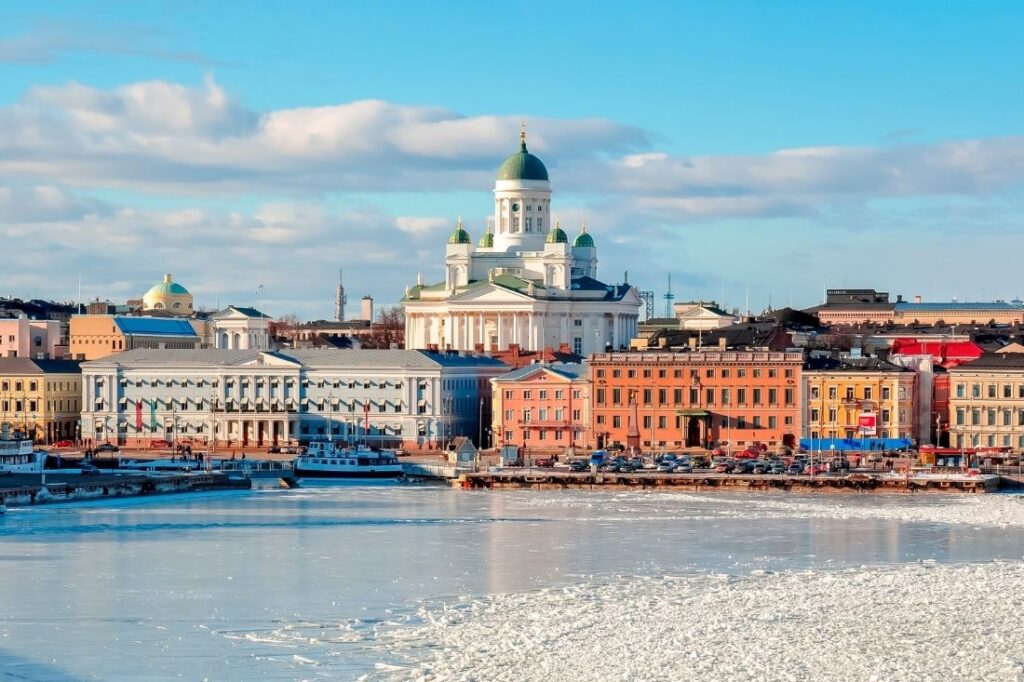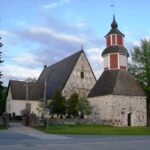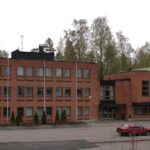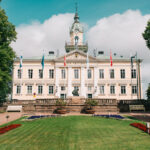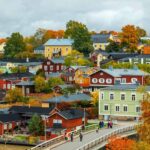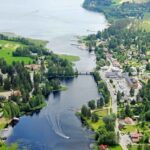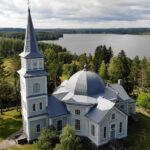Finland is one of the most beautiful countries to visit and live in, offering various educational opportunities for immigrants. This country boasts a high standard of living, and living there can bring you peace and tranquility. The capital city, Helsinki, is an principal hub for industry and economy in the country, and in this article from FinlandQ, we will introduce you to it.
What is the capital city of Finland?
Helsinki is the capital city of Finland, located in the south of the country on the Gulf of Finland. With a population of around 590,000 people, it is the largest city in Finland, and about 7% of its residents are Swedish-speaking. In Swedish, the name of the city of Helsinki is Helsingfors. Helsinki is the largest and most important city in Finland in terms of economy and culture. The urban area of Helsinki is the most important industrial center of the country, with an important port on the Gulf of Finland.
Helsinki directly neighbors the Gulf of Finland, a long gulf in the Baltic Sea. The total area of the city is over 710 square kilometers, with a coastline of 100 kilometers, inviting the city’s inhabitants to go for a walk or an exciting bike ride while enjoying scenic boat tours. This relatively young city was founded in 1550 by King Gustav I of Sweden, who ruled at that time. He wanted to create a port city that would compete with today’s Tallinn (the largest city in Estonia); however, Helsinki did not become the capital of the country until 1812 under Tsar Alexander I. Suomenlinna Fortress, built in 1748 on the offshore islands, was built to protect Helsinki. The houses in this city have been rebuilt in the style of the 1920s and 1930s, patterned after the city of St. Petersburg. The oldest buildings in the Senate Square area should also be seen during a visit to the city.
Overall, this city, with beautiful buildings and a picturesque coastline, is an excellent choice for living and exploring. The city offers bicycles that visitors can use for exploring it. Brochures, maps, accommodation information, and other essential information are available from the Helsinki Tourist and Conference Bureau, which can help tourists visit different parts of the city without getting lost.
Which universities and important organizations does Helsinki host?
Helsinki is home to the government, parliament, and a Lutheran, Orthodox, and Catholic bishop. In addition to the university founded in 1828 and a technical university, there are several other universities in this city. Moreover, this city has a national library, several theaters, a new opera house, and various museums. In 1998, the Museum of Contemporary Art also opened in the capital of Finland.
Helsinki is known for its classical buildings such as the Presidential Palace and the Cathedral, and examples of modern, neoclassical, and contemporary architecture can be found throughout the city. Helsinki is a beautiful city for visitors interested in architecture, where they can see various types of world-renowned architecture in this city. The famous buildings of this city are the ruins of Suomenlinna Castle located in the southeastern part of it. This building was built on several offshore islands in 1748-1772 to protect Helsinki and introduced as a UNESCO World Heritage Site in 1991
The landmark of Helsinki is the Cathedral, located in Senate Square in the center of the city. Aleksanterinkatu, one of the main shopping streets, also starts here, and after visiting the church, you can go shopping on the most beautiful street in the city. Another popular church among tourists is the Temppeliaukio Church, which is built into a rock and completed in 1969. Uspenski Cathedral, built in the Russian-Byzantine style, gives tourists a completely different feeling and has significant differences compared to other churches’ architectures.

Economy and Transportation in the Capital of Finland
Helsinki is the most important industrial center of Finland. Industries such as paper production, mechanical engineering, wood and metal processing, chemical industries, shipbuilding factories, electrical industries, clothing, food, and a Chinese factory are all located in this city. Helsinki has a metro and the Helsinki-Vantaa International Airport. The numerous bays and peninsulas add a unique charm to this city, which also plays an important economic role.
The city is well-connected through a comprehensive transportation system, including buses, trams, trains, and metros, making it easy for locals and tourists to get around. In addition, the city offers bicycle-sharing services to promote sustainable transportation and reduce traffic. Helsinki has a well-developed infrastructure for public transportation, making it one of the easiest cities to navigate in Europe.
Moreover, the port of Helsinki is the busiest passenger port in Finland, with frequent ferry connections to Tallinn, Stockholm, and St. Petersburg. Cruise ships also frequently stop in Helsinki, contributing to the tourism industry and boosting the local economy. Overall, Helsinki’s strategic location, excellent transportation network, and diverse industries make it a crucial player in the Finnish economy.
A Brief History of Helsinki
Helsinki was founded by King Gustav I of Sweden in 1550 at the mouth of the River Vantaa. In 1812, Helsinki became the capital of the Grand Duchy of Finland under Russian rule. Over the years, the city underwent a significant expansion. Helsinki hosted the Conference on Security and Cooperation in Europe (CSCE) in 1973 and 1975.
During the Russo-Swedish War in 1808, Helsinki was burned to the ground. However, after Finland was ceded to Russia in 1809, Tsar Alexander I transferred the capital of the Grand Duchy from Turku to Helsinki in 1812. German architect Carl Ludwig Engel played a significant role in the complete reconstruction of the city, including the construction of the State Council Building, the main building of the University of Helsinki, and the Lutheran Cathedral, known as the Great Church, which was completed in 1852.
The domes of the Uspenski Orthodox Cathedral are some of the recognizable landmarks of the Russian era. When Helsinki became the capital of Finland, its population rapidly increased from 4,000 in 1810 to 60,000 in 1890. Helsinki’s parliament elected the first President of Finland in 1919. In the following decades, Helsinki became a hub for trading, industry, and culture; which was only disrupted by World War II. After the war, Finland was able to recover and rebuild various parts of the country, with the most significant change being the overhaul of the educational system, which is now considered one of the best in the world.
Why Visit Helsinki for Vacation?
You might wonder why you should visit Helsinki for vacation. The simple answer is that Helsinki is a beautiful city where you can spend relaxing days off work. The city has a positive vibe, and it is vibrant and lively, making you feel good when walking around. Helsinki is also an excellent city for shopping and eating out, with a pleasant nightlife. Generally, hotels have great quality and are always equipped with saunas.
The only downside of the city is the high cost of accommodation, which may be expensive for some people. Finland, especially Helsinki, is not a cheap destination for travelers. However, the price paid is justified by the good quality services provided. Eating out in Helsinki feels like attending a grand party because high-quality food is served in attractive dishes. Fish has a special place in this country and is one of Finland’s most popular foods.
The definition of “good shopping” can vary from person to person. For example, in the Netherlands, “good shopping” is often synonymous with “cheap shopping,” whereas in the belief of some people, “good shopping” means buying high-quality items. Helsinki isn’t cheap in terms of prices, but the clothes you find will be unique and of high quality. There is a good chance that you will find good things in Helsinki; clothes that even after years will still be exceptional.

Affordable Options in Helsinki
Hotels and apartments in Helsinki are not cheap, but you can save a considerable amount on your travel expenses by comparing prices on different hotel reservation websites. Different price agreements mean that sometimes you pay tens of percent less for a room compared to other places. There are various websites available that list hotel prices when searching for available hotels in the Finnish capital.
The Capital of Finland is just an amazing entertaining city!
When you visit Helsinki for the first time, you will be amazed. It is a big city but rarely caught up in traffic or overcrowded. The residents of this city are friendly and intimate, creating a very pleasant atmosphere throughout your trip. Helsinki differs from what you may be used to in European city trips, making it a peaceful and serene experience without getting caught up in various crowds.
Depending on the country you live in, food prices may seem high to you, but it is worth paying for. The quality of services provided by Finnish restaurants is high, and they guarantee that you will enjoy delicious food throughout your trip. Don’t let anything discourage you from going to the capital of Finland. If you want to have a dream vacation, fly to Helsinki because you won’t regret it after your trip.

